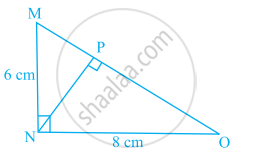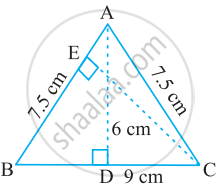Advertisements
Advertisements
प्रश्न
In the given figure, ΔMNO is a right-angled triangle. Its legs are 6 cm and 8 cm long. Length of perpendicular NP on the side MO is ______.

विकल्प
4.8 cm
3.6 cm
2.4 cm
1.2 cm
उत्तर
In the given figure, ΔMNO is a right-angled triangle. Its legs are 6 cm and 8 cm long. Length of perpendicular NP on the side MO is 4.8 cm.
Explanation:

Given, ΔMNO is a right angled triangle.
So, according to Pythagoras theorem,
MO2 = MN2 + NO2
= 62 + 82
= 36 + 64
⇒ MO2 = 100
⇒ MO = `sqrt(100)`
⇒ MO = 10 cm
∴ Area of ΔMNO = `1/2` × Base × Height
⇒ `1/2` × MN × NO = `1/2` × MO × NP
⇒ `1/2` × 6 × 8 = `1/2` × 10 × NP
⇒ NP = `24/5`
⇒ NP = 4.8 cm
APPEARS IN
संबंधित प्रश्न
Find the values of k so that the area of the triangle with vertices (1, -1), (-4, 2k) and (-k, -5) is 24 sq. units.
If the points P(–3, 9), Q(a, b) and R(4, – 5) are collinear and a + b = 1, find the values of a and b.
The vertices of ∆ABC = are A (4, 6), B(1, 5) and C(7, 2). A line is drawn to intersect sides AB and AC at D and E respectively such that `\frac{AD}{AB}=\frac{AE}{AC}=\frac{1}{4}` .Calculate the area of ∆ADE and compare it with the area of ∆ABC
ΔABC is isosceles with AB = AC = 7.5 cm and BC = 9 cm (see the given figure). The height AD from A to BC, is 6 cm. Find the area of ΔABC. What will be the height from C to AB i.e., CE?

Find the area of the quadrilaterals, the coordinates of whose vertices are
(1, 2), (6, 2), (5, 3) and (3, 4)
Show that the following sets of points are collinear.
(1, −1), (2, 1) and (4, 5)
Show that the points O(0,0), A`( 3,sqrt(3)) and B (3,-sqrt(3))` are the vertices of an equilateral triangle. Find the area of this triangle.
A(7, -3), B(5,3) and C(3,-1) are the vertices of a ΔABC and AD is its median. Prove that the median AD divides ΔABC into two triangles of equal areas.
Find the area of the following triangle:

Find the area of the triangle whose vertices are (-2, 6), (3, -6), and (1, 5).
